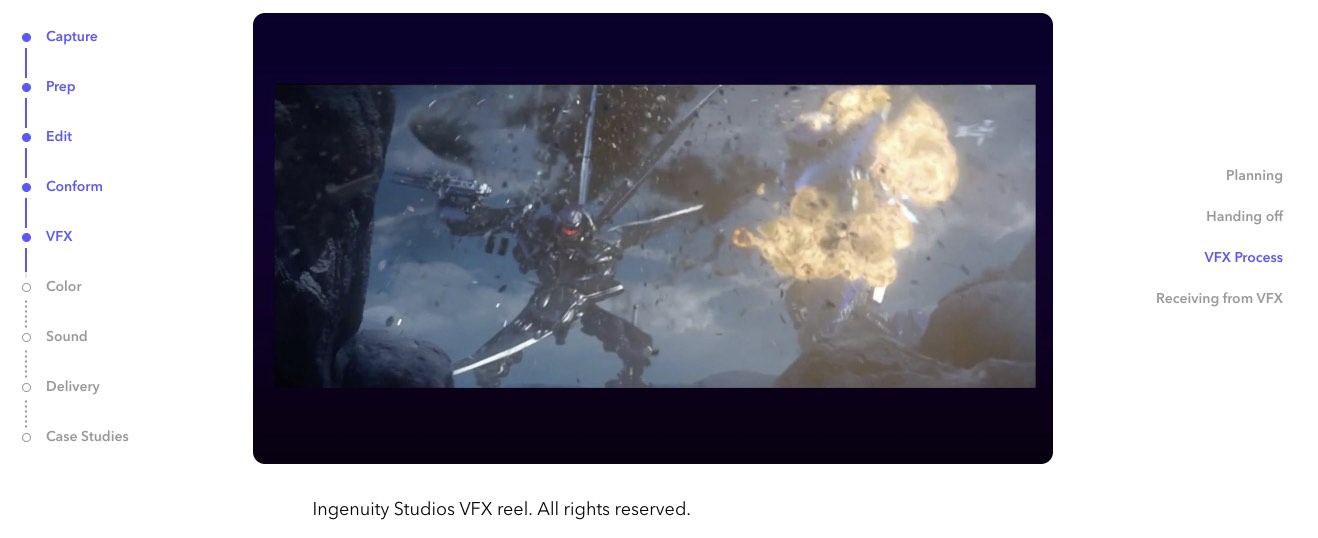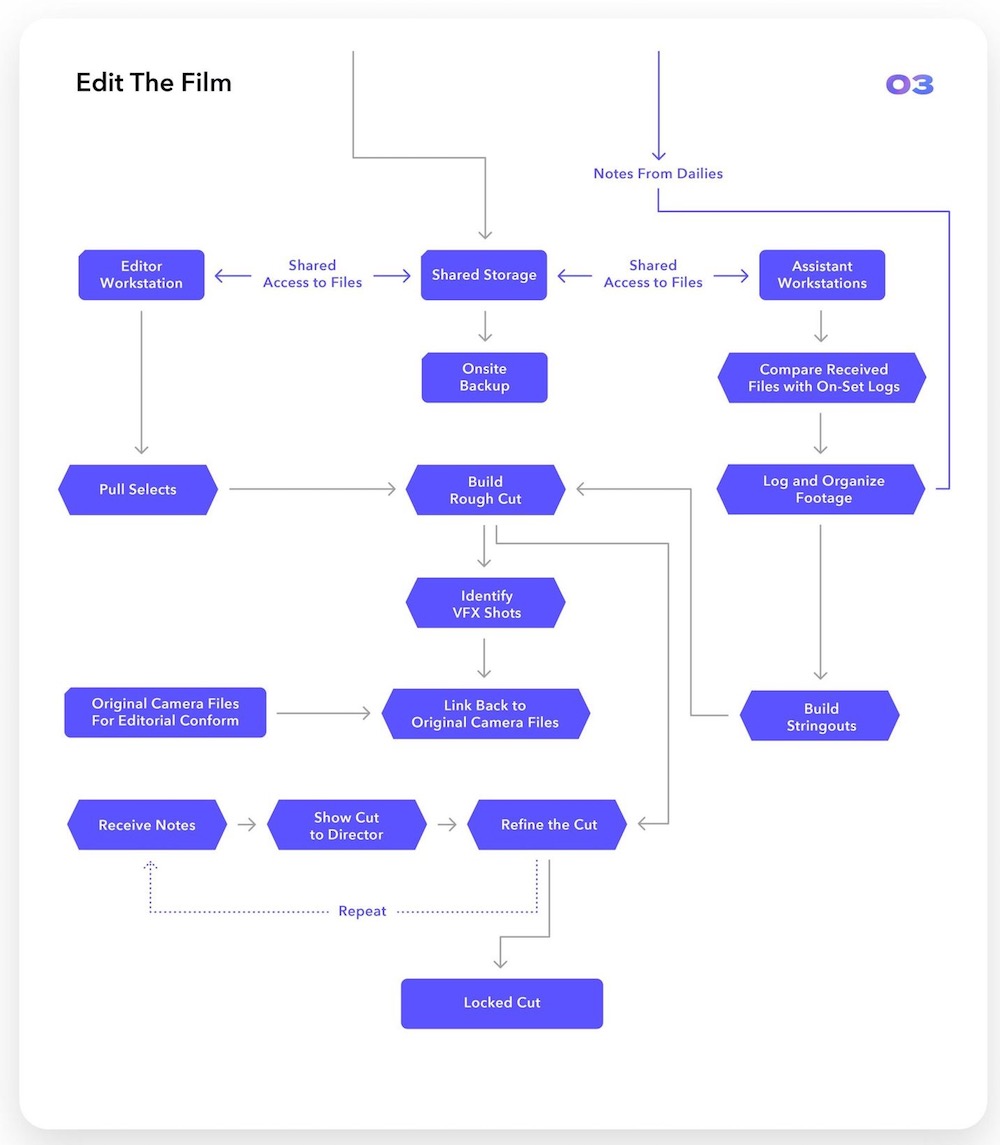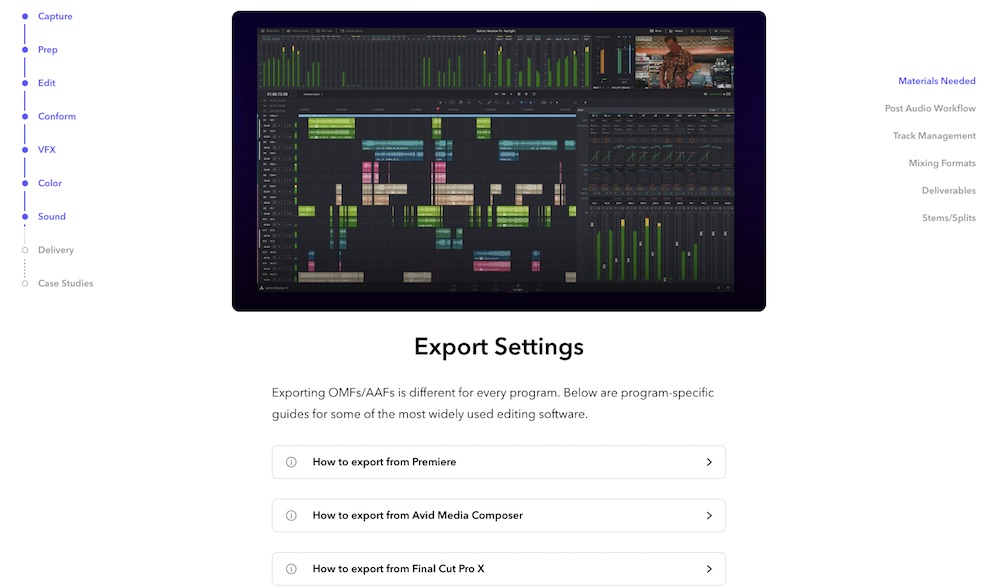Inside Frame.io’s Ultimate Post Production Workflow Guide
If you’ve ever wanted to read a soup-to-nuts overview of the entire post production process, all the way from the camera sensor to the ‘silver screen’ then Frame.io’s new Workflow Guide is what you’ve been waiting for.
I was lucky enough to have early access to the guide, and so I thought I’d put together this quick post highlighting some of my favourite things about it, and a few word’s with it’s mastermind, David Kong.
If you just want to jump to it yourself before reading on then click here: Frame.io Workflow Guide
It’s as comprehensive a guide as you could hope to find for free(!), that’s over 100,000 words long (that’s comparable to a PHD thesis!), and it documents every step of the post-production process with details of how the files and information flow through different roles and departments and what you need to know to successfully navigate that journey yourself.
It’s also a living document that’s going to be growing and evolving over the coming months and years, adding depth to certain areas and keeping pace with the ever-changing nature of post-production workflows.
There are currently 9 chapters covering:
- Capture
- Prep
- Edit
- Conform
- VFX
- Colour
- Sound
- Delivery
- Case Studies
Each chapter then has detailed sub-chapters, so for example, the Edit chapter contains:
- Shared Storage
- Offline Editing
- Project Organisation
- Editing Stages
- Review and Feedback
- Remote Editing
- Hardware and Software
If you’re an experienced editor then the gist of most of the over-arching information probably won’t be new to you, but you may not know the difference between a proxy and mezzanine workflow, or what kind of data rates you can expect to get from a 1 Gigabit Ethernet connection vs a 10 Gigabit connection.
That said, you’ll still learn a ton from picking your way through the other chapters on Capture, VFX, Colour, Sound or Delivery, with some concise descriptions of topics like ACES, common QC flags or what a helpful track layout is when exporting your sound for the mix.
If you’re new to any of this, well then Christmas has come early!
I think the greatest value in this is the fact that it connects all of the dots. It takes the specialised knowledge of many different departments and shows how they connect together. – David Kong, Frame.io
In my chat with David, he mentioned that the goal is not to teach you how to do each of the jobs that are essential to the post production workflow, but to give you the bigger picture. To help you to contextualise what you might already do, day-to-day, in the bigger story of the whole project.
Frame.io Workflow Guide – 5 Nice Features
To give you a quick sense of what’s in the Frame.io Workflow Guide, and how to get the most out of it, I put together this 1 minute video with 5 of my favourite things about it.
1.Night Mode
You can toggle between a light and dark mode on the site depending on your taste or reading environment. It’s a small thing but I really appreciated it!
2. Pop Out Details
One of the smart choices made by the creators of the guide is to include the option to take a deeper dive into a specific piece of content by clicking on numerous pop-out/drop-down details scattered throughout the guide.
These then open up with either a concise primer on a specific term or an exhaustive step-by-step guide to performing a specific task such as creating proxies in the four major NLEs.
It really helps to make the overall guide much more readable and accessible, without diminishing the depth of the content.
3. Navigation
As the guide is so large, the in-page navigation is great, with permanent on-screen contents lists to help you jump to a specific chapter (left side) or sub-chapter (right side).
Another small detail but it makes a huge difference to the user experience!
4. Case Studies
In the last chapter of the Workflow Guide there are 5 in-depth case studies covering a range of production sizes, budgets and audiences.
- Blockbuster – Mission: Impossible
- Independent Film – Searching
- Broadcast Ad – Sunoco
- YouTube Star – Film Riot
- Weddings – Cinemacake
What’s great about these is that they really serve to draw all of the information in the rest of the guide together and further contextualise it in an individual workflow with specific real-world constraints like budget, time, crew and clients.
5. Codec Comparison
The Codec Comparison page is a further extension of the workflow guide which allows you to visually compare the quality and attributes of 46 different codec variants.
There are dozens of codecs out there, and each has their strengths and weaknesses. In this guide, you’ve learned about bit depth, bit rate, chroma subsampling, long-GOP compression, and all of the other important factors when choosing codecs…
… We overlaid the compressed files on top of the original uncompressed DPX files and used the Difference blend mode. The resulting images highlight any areas where the codec is losing information.
In areas where the image is black, the codec has done a great job. In areas where the image is light, the codec has lost information. In order to make the differences easier to see, we increased the brightness slightly.
Inside the Frame.io Workflow Guide with David Kong
I had a quick chat with Frame.io’s Director of Content Strategy, David Kong, to find more about this ambitious new project and where it might go in the future.
David also writes for Frame.io’s excellent blog, which you can check out here.
What was the inspiration for putting something like this together as a single central resource?
The inspiration was that we have seen lots and lots of great pieces of content, which each dig into specific areas, all over the Internet. There are lots of experts writing great content but it’s not unified and so the information is not put in context.
If you’re someone who doesn’t have a lot of experience with colour correction you might want to learn about how colour science works. But the articles that you’re reading are very specific to colour science or colour and might not talk about how colour science impacts VFX.
Or you may just be very much a beginner too. The colour correction process and the articles you read, while valuable may not help you understand the whole process. You might come across an article on; using qualifiers but you don’t understand how qualifiers work together in the whole workflow of the colorist.
So we wanted to create a single resource that tied everything together and tells you how the whole story goes, from choosing the settings on the camera all the way through to choosing the settings on the final export for delivery. So that you can understand how each and every piece fits together as a whole.
What makes the Workflow Guide unique?
When we are setting out to design this, it would have been impossible to create a guide that is so comprehensive that it literally teaches you how to do every job in post-production. That’s just not feasible, it’s just too big.
As ambitious as this project is, we weren’t that ambitious. So our primary goal was not to teach you how to be a colorist or a DIT but to teach you how to understand that person’s job and how to work with them.
So the section on colour is not really for professional colorists. They know all this already, but hopefully it’s very helpful for people who are DITs who need to understand how the colorist is going to work.
It’s helpful for someone who is an assistant editor who needs to understand the priorities of the colourist when we’re talking about how we send files back and forth. It’s useful for the post production supervisor, it’s even potentially useful for the camera operator, because a camera operator also has to understand how those things work, as well as a DIT.
I think the greatest value in this is the fact that it connects all of the dots. It takes the specialised knowledge of many different departments and shows how they connect together.
So for example, the DIT cares about metadata, not because the DIT is going to use that metadata, but because the editorial team, the conform and the colorists are going to use that metadata and we show how all these pieces connect together and we created this gigantic flow chart that shows you, literally with dots and lines and boxes, how the pieces fit together how information flows from one team to another.
So that I think is is probably more valuable than any individual piece. It’s that overview.
Because for any individual article that we have on here, there are other people that have probably written a similar article that also can do the job. So the article that you’ll find here on curves and colour wheels is a great article on curves and colour wheels but there are plenty of people on their YouTube tutorials who that have done that too.
But what we give you here, is the ability to learn about colour curves and colour wheels in the context of the entire process of colour. But not just that, then even the entire process of colour is put into context of the entire post-production process, so you can drill down into what’s interesting to you.
But you can also stay high level if you want to be high level.
How long did it take to put it all together and how many contributors are there?
Let’s see this is December so we started on this in June, so it has been almost five months to put all this together and we’ve worked with around 25 different people. So it’s been a big team effort.
This is not one person sitting down who knows everything and just writing it all out. It’s been a big collaboration between all sorts of people that we’ve worked with before as well as new people and our own internal team.
What do you feel is some of the most valuable info you don’t want people to miss?
I think that the codec comparison is going to be really exciting for people who like to get nerdy about codecs. It’s going to be really really valuable.
Is it a static resource or will it continue to grow – if so, what’s next?
Absolutely not.
It’s not going to be a static resource. It’s going to be growing, it’s growing right now, we are already writing sections today, that are going to go live in the next couple of weeks.
So this is going to be a living document and there are two reasons; one is because we want to do a lot more. And two is because things change. Technologies change, workflows change and we want this resource to be always the latest best practices and standards for how people work together.
So we are working with the writers who contributed to the guide so far, we’re open to working with many new writers, as well as using our internal team to continue building out the resource in many areas.
The other thing is that, our goal for this was not to teach you how to do these jobs but more teach you how to understand all of these jobs, understand the priorities of the person who does that job. That is what we aimed to do with the launch. Sort of version one of the workflow guide but we are hoping to fill out each section in more detail.
So we have a few sections in the guide now that do give you a step by step tutorial and we want to continue expanding that out until you can learn the basic process and tools and not just how the information flow or files flow throughout the process, but also what are the actual tools that are being used. How are they being used? How do you actually click the buttons?
So there is a future goal of taking the entire guide a level deeper. And that is the kind of thing that will take months or maybe years to accomplish, but we have a very lofty goal for the future of this project.
Is there opportunity for others to contribute to the Workflow Guide?
We are very open to having more collaborators. So if you personally or any of your readers has a particular topic that they know really well and they want to insert it into that guide it’s a very flexible format.
We can add more topics, subtopics, sub-subtopics, at any time. Our goal is that it’s more like an open platform where anybody can suggest their own articles or changes to the current text, as workflows march on.
Thanks David
So there you have it, one to bookmark for future reference! Check out the Frame.io Workflow Guide here.









